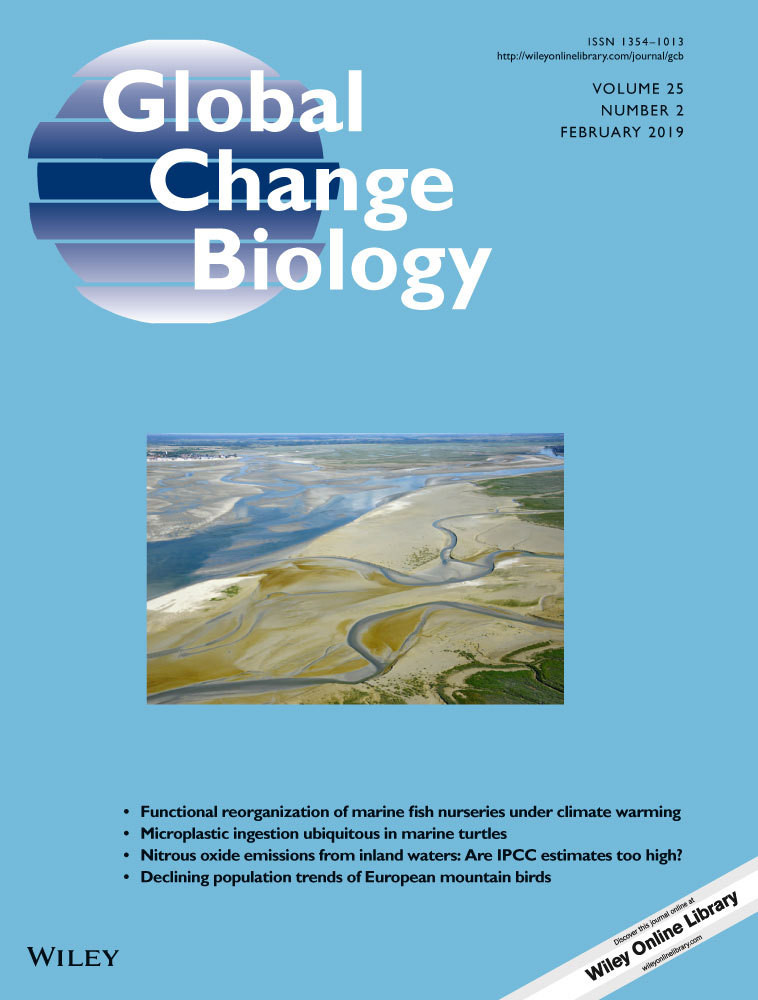Global soil nitrous oxide emissions since the preindustrial era estimated by an ensemble of terrestrial biosphere models: Magnitude, attribution, and uncertainty
Abstract
Our understanding and quantification of global soil nitrous oxide (N2O) emissions and the underlying processes remain largely uncertain. Here, we assessed the effects of multiple anthropogenic and natural factors, including nitrogen fertilizer (N) application, atmospheric N deposition, manure N application, land cover change, climate change, and rising atmospheric CO2 concentration, on global soil N2O emissions for the period 1861–2016 using a standard simulation protocol with seven process-based terrestrial biosphere models. Results suggest global soil N2O emissions have increased from 6.3 ± 1.1 Tg N2O-N/year in the preindustrial period (the 1860s) to 10.0 ± 2.0 Tg N2O-N/year in the recent decade (2007–2016). Cropland soil emissions increased from 0.3 Tg N2O-N/year to 3.3 Tg N2O-N/year over the same period, accounting for 82% of the total increase. Regionally, China, South Asia, and Southeast Asia underwent rapid increases in cropland N2O emissions since the 1970s. However, US cropland N2O emissions had been relatively flat in magnitude since the 1980s, and EU cropland N2O emissions appear to have decreased by 14%. Soil N2O emissions from predominantly natural ecosystems accounted for 67% of the global soil emissions in the recent decade but showed only a relatively small increase of 0.7 ± 0.5 Tg N2O-N/year (11%) since the 1860s. In the recent decade, N fertilizer application, N deposition, manure N application, and climate change contributed 54%, 26%, 15%, and 24%, respectively, to the total increase. Rising atmospheric CO2 concentration reduced soil N2O emissions by 10% through the enhanced plant N uptake, while land cover change played a minor role. Our estimation here does not account for indirect emissions from soils and the directed emissions from excreta of grazing livestock. To address uncertainties in estimating regional and global soil N2O emissions, this study recommends several critical strategies for improving the process-based simulations.
1 INTRODUCTION
Nitrous oxide (N2O) is a long-lived greenhouse gas (GHG) with an atmospheric lifetime of ~116 years (Prather et al., 2015), which traps heat in the earth system (Butterbach-Bahl, Baggs, Dannenmann, Kiese, & Zechmeister-Boltenstern, 2013; Ciais, Sabine, & Bala, 2014; Tian et al., 2016) and also contributes to ozone depletion in the stratosphere (Ravishankara, Daniel, & Portmann, 2009). The concentration of atmospheric N2O has increased from 270 ppb in the preindustrial period to 330 ppb in recent years as a result of anthropogenic industrial and agricultural activities. The fastest increases in the atmospheric N2O concentration were seen in recent decades with an average of 0.73 ppb/year (Ciais et al., 2014).
Since the onset of industrialization, the global nitrogen (N) cycle has been continuously disturbed by human activities, especially after the invention of industrial N2 fixation (Gruber & Galloway, 2008). With human population growth, the demand for more food production requires a substantial addition of reactive N (chemical fertilizer and manure) into the cropland soils including land areas used for row crop cultivation. Over recent decades, the enhanced fertilizer use in conjunction with the expansion of legume crops leads to higher soil N2O emissions (Ciais et al., 2014; Montzka, Dlugokencky, & Butler, 2011; Zaehle, Ciais, Friend, & Prieur, 2011). Meanwhile, soils from predominantly natural systems, especially the tropical forests, which are N rich and contain many N-fixing tree species, contributed a large portion to the global N2O emissions (Ciais et al., 2014; van Lent, Hergoualc'h, & Verchot, 2015). In recent decades, N2O emissions from terrestrial soils are the primary source for atmospheric N2O (Butterbach-Bahl et al., 2013; Davidson & Kanter, 2014; Smith, 1997), accounting for ~60% of all global N2O emission sources (Syakila & Kroeze, 2011; Werner, Butterbach-Bahl, Haas, Hickler, & Kiese, 2007). A comprehensive assessment of soil N2O emissions, therefore, is of particular importance for understanding climate–ecosystem interaction and future climate change.
Investigation of N2O emissions from soils has been a key research topic for decades (Bouwman, Fung, Matthews, & John, 1993; Eichner, 1990; Gruber & Galloway, 2008; Syakila & Kroeze, 2011; Xu et al., 2017). Field measurements have been extensively implemented across various biome types and climate zones (Bouwman, Boumans, & Batjes, 2002; Liu & Greaver, 2009; Smith & Dobbie, 2001). However, up-scaling soil N2O emissions from sites to regional and global scales is still a challenge, mainly because of the variable characteristics and complicated mechanisms of N2O emissions controlled by multiple biotic and abiotic factors (Butterbach-Bahl & Dannenmann, 2011). Current methods in estimating large-scale N2O emissions can be separated into two broad categories: bottom-up and top-down approaches. Bottom-up approaches estimate N2O emissions according to inventories, statistical extrapolation of field measurements, and/or Terrestrial Biosphere Models (TBMs), while top-down approaches estimate emissions by integrating atmospheric measurements and atmospheric inversion models (Davidson & Kanter, 2014; Saikawa et al., 2014; Thompson et al., 2014; Tian et al., 2016). Results of both approaches have considerable uncertainties, and estimates of soil N2O emissions show significant divergences across studies. For example, in the Intergovernmental Panel on Climate Change Fifth Assessment (IPCC AR5; Ciais et al., 2014), global natural and anthropogenic N2O emissions from land and ocean estimated by bottom-up approaches ranged between 8.1 and 30.7 Tg N2O-N/year.
The use of Emission Factors (EF) is one common bottom-up approach to quantify N2O emissions from synthetic N fertilizer. The IPCC Tier 1 Protocol 2006 (De Klein, Novoa, & Ogle, 2006) recommended assuming by default that 1% of synthetic N fertilizer use in land ecosystems is directly emitted to the atmosphere in the form of N2O gas (i.e., EF equals 1%). Based on the EF in the IPCC Tier 1 Protocol 2006, FAOSTAT (FAOSTAT, 2016) and the Emissions Database for Global Atmospheric Research (EDGAR; Janssens-Maenhout et al., 2017) provided sectoral estimates of N2O emissions. However, the assumption of constant EF has been questioned because of an inability to depict spatial and temporal variations of N2O emissions and to reflect the impacts of changing environments over time. For example, Shcherbak, Millar, and Robertson (2014) found a faster growing nonlinear response of N2O emissions to N inputs; additionally, soil N2O emissions are affected by soil moisture, temperature conditions, and pH value (Del Grosso & Parton, 2012; Schindlbacher, Zechmeister-Boltenstern, & Butterbach-Bahl, 2004; Wang et al., 2018), as well as freeze/thaw events and livestock management (Wagner-Riddle et al., 2017; Wolf et al., 2010).
Model simulation is another important bottom-up approach to quantify soil N2O emissions at regional, sectorial, and global scales (Del Grosso et al., 2000; Li, Aber, Stange, Butterbach-Bahl, & Papen, 2000; Parton et al., 2001; Tian et al., 2015; Tian, Yang, & Lu, 2018; Xu-Ri, Spahni, & Niu, 2012). One notable advantage of the modeling approach is that it tends to describe the overall N cycle within the land systems and can integrate various driving factors (such as fertilizer application, atmospheric N deposition, and climate change) controlling soil N2O production and emissions. Due to differences in model structure, parameterization schemes, and input data, simulated soil N2O emissions diverged considerably in previous estimates. For example, Xu-Ri et al. (2012) reported that global N2O emissions from natural soil were 8.3 ~ 10.3 Tg N2O-N/year over the 20th century, while Huang and Gerber (2015) simulated lower natural soil N2O emissions of 6.7 Tg N2O-N/year in recent decades.
Nitrification and denitrification are two key processes for soil N2O production, which are regulated by soil temperature, water content, oxygen levels, pH value, and substrate (NO3− and NH4+) availability (Bouwman et al., 2002; Butterbach-Bahl et al., 2013; Davidson, Keller, Erickson, Verchot, & Veldkamp, 2000). These two processes have been parameterized in models by using different mathematical algorithms (Firestone & Davidson, 1989; Li et al., 2000; Parton et al., 2001; Potter, Matson, Vitousek, & Davidson, 1996; Xu-Ri & Prentice, 2008). Besides, other N-related processes affecting mineral N concentration and N2O production in soils (such as biological N fixation, plant N uptake, soil N mineralization and immobilization, and N leaching) are also parameterized differently in TBMs (Tian et al., 2018). Pasture and rangeland (grassland used for grazing animals) emit sizeable N2O gas from livestock excreta deposition, manure, and mineral fertilizer application (Davidson, 2009; Steinfeld, Gerber, Wassenaar, Castel, & DeHaan, 2006). Although some models such as DNDC (Giltrap & Ausseil, 2016; Li, Frolking, & Frolking, 1992; Saggar et al., 2004), the daily version of the CENTURY ecosystem model (DayCent; Abdalla et al., 2010; Del Grosso, Mosier, Parton, & Ojima, 2005; Parton, Hartman, Ojima, & Schimel, 1998), and the Soil and Water Assessment Tool (SWAT; Arnold et al., 2012; Shrestha, Thomas, Du, Hao, & Wang, 2018) simulated N2O emission from pasture soils, most global-level model simulations have not considered the impacts of pasture management practices and livestock excreta deposition, which leads to the underestimation of soil N2O emissions from world’s grasslands (Dangal et al., In revision). The differences in model input datasets (such as climate data, land use and land cover, and N deposition) can be another important source of uncertainty in model simulations. Thus, consistent and accurate input datasets are particularly necessary to narrow the uncertainty range of the simulated soil N2O emissions across the process-based models.
The global N2O Model Intercomparison Project (NMIP) has been initiated under the umbrella of the Global Carbon Project (GCP) and the International Nitrogen Initiative (INI) and aims to quantify long-term N2O emissions from global soils and determine the contributions of multiple environmental factors to emissions (Tian et al., 2018). In the NMIP, participating TBMs simulated global soil N2O emissions during the period of 1861–2016, following the same simulation protocol and driven by consistent input datasets, including direct human input of reactive N, and climate and atmospheric composition fields. The specific objectives of our study are to: (a) quantify the magnitude and spatiotemporal patterns of global soil N2O emissions from the preindustrial period to the contemporary period; (b) identify the critical regions making significant contributions to increased soil N2O emissions; (c) attribute the changed N2O emissions to natural and anthropogenic factors; and (d) discuss uncertainties of estimated emissions and provide insights for model improvement and future research directions.
2 MATERIALS AND METHODS
2.1 The global N2O Model Intercomparison Project
Currently, ten process-based Terrestrial Biosphere Models (TBMs) participate in N2O Model Intercomparison Project (NMIP), all of which explicitly consider terrestrial carbon (C), N, and water cycling processes, and simulate soil N2O emissions (Tian et al., 2018). Driven by consistent input datasets (i.e., climate, atmospheric CO2 concentration, land cover change, atmospheric N deposition, mineral N fertilization, and manure N application), each model team implemented seven simulation experiments (SE0–SE6, Table 1) at the spatial resolution of 0.5° globally covering the period of 1861–2016. In SE0, all driving factors were kept constant at the levels in 1860 over the entire simulation period, while in SE1, all factors changed over time. Each modeling group was requested to simulate and submit terrestrial C- and N-related variables at grid- and biome-scales for model ensemble analysis.
| CLIM | CO2 | LCC | NDEP | NFER | MANN | |
|---|---|---|---|---|---|---|
| SE0 | 1901–1920* | 1860 | 1860 | 1860 | 1860 | 1860 |
| SE1 | 1901–2016 | 1860–2016 | 1860–2016 | 1860–2016 | 1860–2016 | 1860–2016 |
| SE2 | 1901–2016 | 1860–2016 | 1860–2016 | 1860–2016 | 1860–2016 | 1860 |
| SE3 | 1901–2016 | 1860–2016 | 1860–2016 | 1860–2016 | 1860 | 1860 |
| SE4 | 1901–2016 | 1860–2016 | 1860–2016 | 1860 | 1860 | 1860 |
| SE5 | 1901–2016 | 1860–2016 | 1860 | 1860 | 1860 | 1860 |
| SE6 | 1901–2016 | 1860 | 1860 | 1860 | 1860 | 1860 |
Notes
- CLIM: climate condition; CO2: atmospheric CO2 concentration; LCC: land cover change; MANN: manure N use in cropland; NDEP: atmospheric N deposition; NFER: mineral N fertilizer use; SE0: baseline and control run with repeated climate forcing from 1901 to 1920; SE1: CLIM + CO2 + LCC + NDEP + NFER + MANN; SE2: CLIM + CO2 + LCC + NDEP + NFER; SE3: CLIM + CO2 + LCC + NDEP; SE4: CLIM + CO2 + LCC; SE5: CLIM + CO2; SE6: CLIM. “1901–1920*” denotes that variable is constant at the level of 20-year average; “1860” denotes that variable is constant at the level of 1860; and “1860–2016” denotes that variable changes with time over the study period.
NMIP model input datasets were collected from various sources. Climatic conditions were acquired from the CRU-NCEP v8 climate dataset (https://vesg.ipsl.upmc.fr); atmospheric CO2 concentration was from the NOAA GLOBALVIEW-CO2 dataset (https://www.esrl.noaa.gov); gridded cropland area was from the HYDE 3.2 dataset (ftp://ftp.pbl.nl/hyde/); N deposition was obtained from the IGAC/SPARC Chemistry-Climate Model Initiative (CCMI); and N fertilization and manure N application datasets were developed specifically for the NMIP project (Lu & Tian, 2017; Zhang et al., 2017). NMIP did not provide consistent crop type and rotation datasets because (a) the participating models have different crop classification schemes, and some models consider crop rotation while others do not; and (b) global-level cropping system datasets covering the entire simulation period (1860–2016) are not available. NMIP models, therefore, have the flexibility to use their default strategies to represent crop type and rotation. In this study, NMIP simulation protocol considered external manure inputs to cropland but did not include manure deposition and application in pasture and manure management as most NMIP models do not simulate N2O emissions from animal excreta in grassland, which may lead to uncertainties (see Discussion section). The detailed NMIP simulation protocol, including model spin-up strategies, benchmarking, output variables, and quality control approaches, is given in Tian et al. (2018).
In this study, we set four criteria to screen the participating models: (a) SE0 and SE2-SE6 were implemented; (b) grid-level N2O emissions and N2O emissions from cropland and natural soils were provided; (c) no significant trend (increasing or decreasing) of the simulated global N2O emissions in SE0 to ensure no drift in model simulation; and (d) the simulated N2O emissions should be responsive to each of the environmental drivers. Finally, 7 of the 10 participating models were selected to estimate N2O emissions from both cropland and natural soils and to quantify the relative contributions of each driving factor. These seven models are as follows: (1) the Dynamic Land Ecosystem Model (DLEM; Tian et al., 2015; Xu et al., 2017), (2) Lund-Potsdam-Jena-General Ecosystem Simulator (LPJ-GUESS; Olin et al., 2015; Xu-Ri & Prentice, 2008), (3) Land Processes and eXchanges model-Bern (LPX-Bern v1.4; Lienert & Joos, 2018; Stocker et al., 2013; Xu-Ri & Prentice, 2008), (4) O-CN (Zaehle et al., 2011), (5) Organising Carbon and Hydrology In Dynamic Ecosystems (ORCHIDEE, Vuichard et al. 2018), (6) Organising Carbon and Hydrology In Dynamic Ecosystems-Carbon Nitrogen Phosphorus (ORCHIDEE-CNP; Goll et al., 2017), and (7) Vegetation Integrated Simulator for Trace gases (VISIT, Inatomi, Ito, Ishijima, & Murayama, 2010; Ito & Inatomi, 2012; See more model information in Supporting Information Table S1). Five models (DLEM, LPJ-GUESS, ORCHIDEE, ORCHIDEE-CNP, and VISIT) considered the effects of manure use in cropland and ran all the seven simulation experiments (S0–S6), while the other two models (LPX-Bern and O-CN) did not include manure effects and ran six model experiments (all except SE1). Note that N2O emissions from ground water and rivers are not included in these models.
2.2 Assessment of soil N2O emissions and attribution analysis
The SE1 includes all driving factors for models with manure addition, and the SE2 is the experiment including all the driving factors for models except manure N. We, therefore, used the SE1 results of five models with manure considered and SE2 results of two models without manure considered as the “best estimate” of soil N2O emissions. The “best estimate” of the seven models was further averaged to estimate the preindustrial and contemporary patterns of soil N2O emissions. In the SE0 simulation, driving forces were kept constant at the level in 1860 over the entire simulation period (1861–2016). SE0 is the “control run” with no trend in any input data and shows no increasing or decreasing trend in the simulated soil N2O emissions if there is no long-term model drift. The simulations in SE0 by all seven models were used to define the preindustrial level of soil N2O emissions. By comparing results from different model scenarios (Table 1), it is possible to attribute the changed spatiotemporal variations of soil N2O emissions to the variations of six natural and anthropogenic factors, namely, climate (CLIM, including precipitation, humidity, temperature and photosynthetic active radiation changes), atmospheric CO2 concentration (CO2), land cover change (LCC), atmospheric N deposition (NDEP), mineral N fertilizer use (NFER), and manure N use in cropland (MANN). Note that the MANN effect was calculated based on the results of five models, while the effects of other driving factors (NFER, NDEP, LCC, CO2, and CLIM) were estimated based on the results of seven models. The estimated contributions were relative to the levels of driving factors in preindustrial period. In order to understand soil N2O emissions dynamics caused by crop cultivation, we further separated the global and regional N2O emissions into those derived from cropland soils and those from soils of other land ecosystems. Except for cropland, the current NMIP simulations do not include management practices (such as grazing and forest logging) for other managed ecosystems such as pasture, planted forests, and urban. All soils in other land ecosystems except cropland were treated as “natural soils” while model simulations were implemented in this study.
2.3 Regional boundaries
While analysis in each model was performed at a 0.5° grid, display of results also took advantage of specific global regions. A new map was designed in this study to divide the global ice-free land area (Greenland and Antarctic excluded) into 18 regions (see Supporting Information Figure S1) for reporting soil N2O emissions at the regional level. The 18 regions are USA (9.4 Million km2), Canada (CAN, 9.8 Million km2), Central America (CAM, 2.7 Million km2), Northern South America (NSA, 2.7 Million km2), Brazil (BRA, 8.5 Million km2), Southwest South America (SSA, 6.4 Million km2), Europe (EU, 5.7 Million km2), Northern Africa (NAF, 15.2 Million km2), Equatorial Africa (EQAF, 8.2 Million km2), Southern Africa (SAF, 6.6 Million km2), Russia (RUS, 16.8 Million km2), Central Asia (CAS, 5.5 Million km2), Middle East (MIDE, 6.1 Million km2), China (CHN, 9.4 Million km2), Korea and Japan (KAJ, 0.6 Million km2), South Asia (SAS, 5.1 Million km2), Southeast Asia (SEAS, 4.8 Million km2), and Oceania (OCE, 8.0 Million km2).
3 RESULTS
3.1 Preindustrial soil N2O emissions
As indicated by HYDE 3.2 land cover data, cropland area was 6.2 × 106 km2 in 1860, equivalent to ~40% of the cropland area in the recent decade. Manure use in cropland was estimated as 2.9 Tg N/year, and no mineral fertilizer was applied to cropland. Soil N2O emissions in the preindustrial period provide a baseline for understanding how intensified human activities have disturbed the patterns of soil N2O emissions. We found that global soil N2O emissions in the preindustrial period were 6.3 ± 1.1 Tg N2O-N/year (model ensemble mean ± 1 SD, same hereafter, Table 2) and the average emission density was 0.05 ± 0.01 g N/m2 ice-free land area per year (Figure 1). The lowest and highest N2O emissions were simulated by ORCHIDEE-CNP (5.1 Tg N2O-N/year) and LPJ-GUESS (8.6 Tg N2O-N/year), respectively (see spatial patterns of the simulated soil N2O emissions by individual models in Supporting Information Figure S2). N2O emissions along a latitudinal gradient (Figure 2a) showed a single peak in the tropics (23.5°N–23.5°S in this study), which contributed 69% to the global total soil N2O emissions. Soil N2O emission density in the tropics (0.09 ± 0.02 g N m−2 year−1) was also 85% higher than that of the global average. Of all the 18 regions, the four tropical regions (EQAF, BRA, NSA, and SEAS) were associated with the highest N2O emission density (Figure 3): 0.13 g N m−2 year−1, 0.12 g N m−2 year−1, 0.12 g N m−2 year−1, and 0.10 g N m−2 year−1, respectively.
| Preindustrial | 1960s | 1970s | 1980s | 1990s | 2000s | 2007–2016 | |
|---|---|---|---|---|---|---|---|
| Global | 6.3 ± 1.1 | 7.2 ± 1.2 | 7.5 ± 1.5 | 8.4 ± 1.6 | 9.0 ± 1.8 | 9.5 ± 1.8 | 10.0 ± 2.0 |
| 1. USA | 0.4 ± 0.2 | 0.6 ± 0.2 | 0.7 ± 0.3 | 0.7 ± 0.3 | 0.8 ± 0.3 | 0.8 ± 0.3 | 0.8 ± 0.3 |
| 2. CAN | 0.1 ± 0.1 | 0.1 ± 0.1 | 0.1 ± 0.1 | 0.1 ± 0.1 | 0.1 ± 0.1 | 0.2 ± 0.1 | 0.2 ± 0.1 |
| 3. CAM | 0.2 ± 0.1 | 0.2 ± 0.1 | 0.2 ± 0.1 | 0.2 ± 0.1 | 0.3 ± 0.1 | 0.3 ± 0.1 | 0.3 ± 0.1 |
| 4. NSA | 0.3 ± 0.1 | 0.4 ± 0.1 | 0.3 ± 0.1 | 0.4 ± 0.1 | 0.4 ± 0.1 | 0.4 ± 0.1 | 0.4 ± 0.1 |
| 5. BRA | 1.0 ± 0.3 | 1.1 ± 0.3 | 1.0 ± 0.2 | 1.0 ± 0.2 | 1.1 ± 0.3 | 1.1 ± 0.2 | 1.2 ± 0.3 |
| 6. SSA | 0.4 ± 0.2 | 0.5 ± 0.2 | 0.4 ± 0.2 | 0.4 ± 0.2 | 0.5 ± 0.2 | 0.5 ± 0.2 | 0.5 ± 0.2 |
| 7. EU | 0.2 ± 0.1 | 0.4 ± 0.2 | 0.5 ± 0.2 | 0.6 ± 0.3 | 0.6 ± 0.3 | 0.6 ± 0.3 | 0.6 ± 0.3 |
| 8. NAF | 0.4 ± 0.1 | 0.4 ± 0.1 | 0.5 ± 0.2 | 0.5 ± 0.2 | 0.5 ± 0.2 | 0.5 ± 0.1 | 0.5 ± 0.1 |
| 9. EQAF | 1.1 ± 0.3 | 1.1 ± 0.2 | 1.1 ± 0.2 | 1.2 ± 0.2 | 1.2 ± 0.3 | 1.2 ± 0.2 | 1.2 ± 0.2 |
| 10. SAF | 0.4 ± 0.1 | 0.4 ± 0.1 | 0.5 ± 0.1 | 0.5 ± 0.1 | 0.5 ± 0.1 | 0.5 ± 0.1 | 0.5 ± 0.1 |
| 11. RUS | 0.3 ± 0.2 | 0.4 ± 0.3 | 0.4 ± 0.3 | 0.5 ± 0.3 | 0.4 ± 0.3 | 0.4 ± 0.3 | 0.4 ± 0.3 |
| 12. CAS | 0.1 ± 0.0 | 0.1 ± 0.0 | 0.1 ± 0.0 | 0.1 ± 0.0 | 0.1 ± 0.0 | 0.1 ± 0.0 | 0.1 ± 0.0 |
| 13. MIDE | 0.0 ± 0.0 | 0.1 ± 0.0 | 0.1 ± 0.0 | 0.1 ± 0.1 | 0.1 ± 0.1 | 0.1 ± 0.1 | 0.1 ± 0.1 |
| 14. CHN | 0.3 ± 0.1 | 0.4 ± 0.1 | 0.4 ± 0.1 | 0.6 ± 0.2 | 0.9 ± 0.4 | 1.1 ± 0.5 | 1.4 ± 0.8 |
| 15. KAJ | 0.0 ± 0.0 | 0.0 ± 0.0 | 0.0 ± 0.0 | 0.1 ± 0.0 | 0.1 ± 0.0 | 0.1 ± 0.0 | 0.1 ± 0.0 |
| 16. SAS | 0.4 ± 0.1 | 0.4 ± 0.1 | 0.5 ± 0.1 | 0.6 ± 0.2 | 0.7 ± 0.2 | 0.7 ± 0.2 | 0.9 ± 0.3 |
| 17. SEAS | 0.5 ± 0.2 | 0.5 ± 0.2 | 0.5 ± 0.2 | 0.6 ± 0.2 | 0.7 ± 0.2 | 0.7 ± 0.2 | 0.7 ± 0.2 |
| 18. OCE | 0.3 ± 0.1 | 0.3 ± 0.1 | 0.3 ± 0.2 | 0.4 ± 0.1 | 0.4 ± 0.1 | 0.4 ± 0.2 | 0.4 ± 0.1 |
Note
- The letters stand for 18 regionals, including USA, Canada (CAN), Central America (CAM), Northern South America (NSA), Brazil (BRA), Southwest South America (SSA), Europe (EU), Northern Africa (NAF), Equatorial Africa (EQAF), Southern Africa (SAF), Russia (RUS), Central Asia (CAS), Middle East (MIDE), China (CHN), Korea and Japan (KAJ), South Asia (SAS), Southeast Asia (SEAS), and Oceania (OCE).
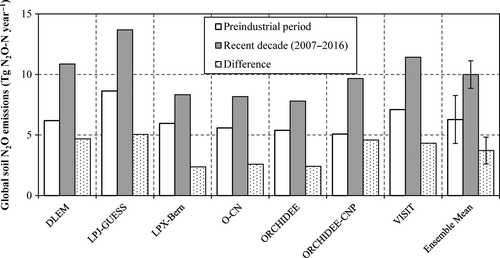
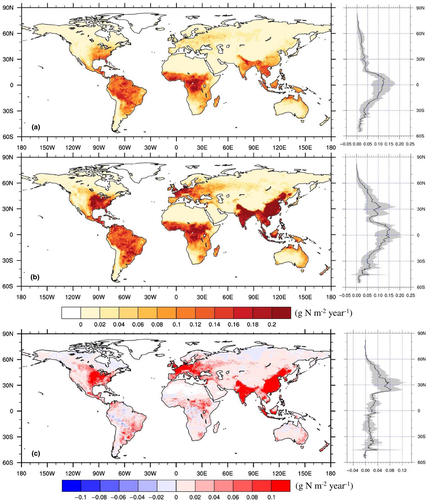
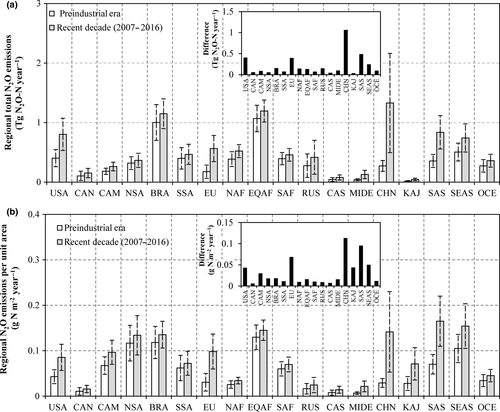
Due to less intensive land management in the preindustrial period, soil N2O emission density in cropland (0.04 ± 0.02 g N m−2 year−1) was comparable to that in other ecosystems (0.05 ± 0.01 g N m−2 year−1). Cropland soil N2O emissions were 0.3 ± 0.1 Tg N2O-N/year and contributed only ~4% to the global total soil N2O emissions. N2O emissions from natural soil were estimated to be 6.0 ± 1.1 Tg N2O-N/year (see spatial patterns in Figure 4).
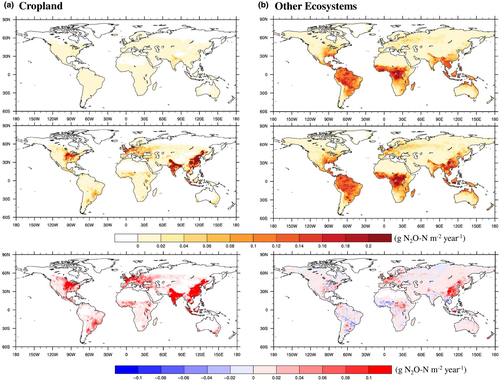
3.2 Soil N2O emissions in the recent decade
In the recent decade (2007–2016), global soil N2O emissions were estimated to be 10 ± 2.0 Tg N2O-N/year, and the average emission density was 0.07 ± 0.01 g N m−2 year−1 according to the “best estimate” of model simulations (Figure 1 and Table 2). ORCHIDEE simulated the lowest global soil N2O emissions (7.8 Tg N2O-N/year), while LPJ-GUESS simulated the highest global soil N2O emissions (13.6 Tg N2O-N/year) (see spatial patterns of the simulated soil N2O emissions by individual models in Supporting Information Figure S3). A latitudinal gradient of N2O emissions displays two peaks, one in the tropics and the other in the temperate region of the Northern Hemisphere (Figure 2b). Tropical soil N2O emissions were 5.3 ± 0.9 Tg N2O-N/year, accounting for ~53% of global total soil N2O emissions. N2O emission density in the tropics was 0.11 ± 0.02 g N m−2 year−1, which is 51% higher than the global average soil N2O emission density. Regionally, the four tropical regions (EQAF, BRA, NSA, and SEAS) had high soil N2O emission densities (0.14 g N m−2 year−1, 0.14 g N m−2 year−1, 0.13 g N m−2 year−1, and 0.15 g N m−2 year−1, respectively). In addition, SAS and CHN also had high soil N2O emission density (0.16 g N m−2 year−1 and 0.14 g N m−2 year−1, respectively), indicating that regions with high soil N2O emissions rate expanded from the tropical forest regions to cropland-dominant regions.
Soil N2O emissions were 3.3 ± 1.1 Tg N2O-N/year in cropland, and 6.7 ± 1.4 Tg N2O-N/year in other ecosystems (see spatial patterns of soil N2O emissions from cropland and other ecosystems in Figure 4). Soil N2O emission density of cropland (0.21 ± 0.08 g N m−2 year−1) was more than three times that of other ecosystems (0.06 ± 0.01 g N m−2 year−1). Although global cropland area was only ~13% of the ice-free land area, the contribution of cropland soil N2O emissions to global total soil N2O emissions reached as much as 33% (Figure 5). For cropland, DLEM simulated the highest soil N2O emissions (5.0 Tg N2O-N/year), and LPX-Bern and ORCHIDEE simulated the lowest (1.7 and 1.8 Tg N2O-N/year). For other ecosystems, the highest soil N2O emissions were simulated by LPJ-GUESS (9.5 Tg N2O-N/year), and the lowest was simulated by OCN (5.5 Tg N2O-N/year).
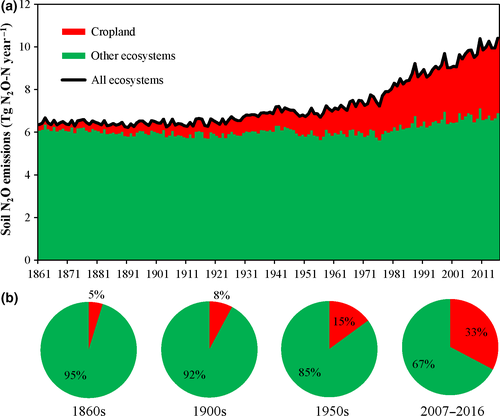
3.3 Spatial and temporal changes in soil N2O emissions
From the preindustrial period to the recent decade, global soil N2O emissions increased by 59% (3.7 ± 1.1 Tg N2O-N/year), and the emission density increased on average by 0.03 ± 0.01 g N m−2 year−1. Of the seven models, LPJ-GUESS simulated the largest increases (5.1 Tg N2O-N/year), while LPX-Bern and ORCHIDEE simulated the smallest (2.4 Tg N2O-N/year; Figure 1, also see spatial patterns of the changed soil N2O emissions simulated by individual models in Supporting Information Figure S4). The model ensemble mean showed that the most significant increases occurred in the mid-latitudes of the Northern Hemisphere (Figure 2). Soil N2O emissions increased across all the 18 regions (Table 2). Particularly, CHN, SAS, and EU were the three regions showing the fastest increases in N2O emission density (Figure 3). The increased emission density in the three regions (0.11 g N m−2 year−1 for CHN, 0.09 g N m−2 year−1 for SAS, and 0.07 g N m−2 year−1 for EU) was 2 ~ 4 times that of global average increase rate.
Global cropland soil N2O emissions increased by 3.0 ± 1.1 Tg N2O-N/year (~11 times) from the preindustrial period to the recent decade, contributing the majority (82%) to the increased global soil N2O emissions (Figure 5). DLEM simulated the largest increase (4.7 Tg N2O-N/year), while LPX-Bern and ORCHIDEE simulated the smallest increase (1.6 Tg N2O-N/year) (Supporting Information Figure S5). At the regional level, the largest increases in cropland N2O emissions were found in CHN, SAS, USA, EU, and SEAS, which accounted for 27%, 15%, 11%, 9%, and 8% of the increased global cropland N2O emissions, respectively. CHN, SAS, and SEAS underwent rapid increases of cropland N2O emissions since the 1970s (Figure 6). Cropland N2O emissions in these three regions increased by more than 200% from the 1970s to the recent decade (Supporting Information Table S2). In contrast, US cropland N2O emissions were relatively stable since the 1980s, and EU cropland N2O emissions even decreased by an estimated 14% from the 1980s to the recent decade.
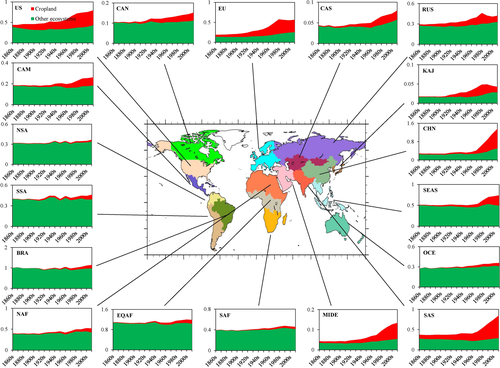
From the preindustrial period to the recent decade, global N2O emissions from natural soils showed a relatively small increase of 0.7 ± 0.5 Tg N2O-N/year (11%) although total area decreased (Figure 5). Of all the regions, N2O emissions from natural soil increased by more than 50% in CHN, KAJ, and EU (Figure 6 and Supporting Information Table S3).
3.4 Contributions of factors responsible for the increased N2O emissions
Variations in temporal and spatial patterns of soil N2O emissions were attributed to multiple land use-related factors, climate, as well as atmospheric composition factors (Figures 7 and 8). Over the study period, manure and N fertilizer addition (MANN and NFER), N deposition (NDEP), and climate change (CLIM) were found to increase soil N2O emissions, in part through increases in mineral N in soils that serve as a substrate for the N2O-producing nitrification and denitrification processes (Figure 7). During the period of 2007–2016, the MANN effect on soil emission was 0.6 ± 0.4 Tg N2O-N/year. The NFER effect resulted in continuous increases of soil N2O emissions, and thus turned croplands into the dominating factor behind the increasing global soil N2O emissions since the 1970s. During the period of 2007–2016, NFER effect contributed 2.0 ± 0.8 Tg N2O-N/year, accounting for 54% of the increased terrestrial N2O emissions compared to the preindustrial situation. During the period of 2007–2016, NDEP was the second largest contributing factor, contributing 26% to increased soil N2O emissions. The seven models in this study agreed that the effects of direct (MANN and NFER) and indirect (NDEP) anthropogenic N additions to land ecosystems enhanced global soil N2O emissions, although the magnitudes of contributions varied considerably (Supporting Information Figure S6). LPJ-GUESS was the most sensitive to N addition. The lowest contributions of MANN, NFER, and NDEP were simulated by VISIT, ORCHIDEE, and LPX-Bern, respectively. From the preindustrial period to the recent decade (2007–2016), the increased amount of N additions (including MANN, NFER, and NDEP) was 174 Tg N/year, which enhanced soil N2O emissions by 3.5 ± 0.9 Tg N2O-N/year, accounting for 96% of the increased global soil N2O emissions.
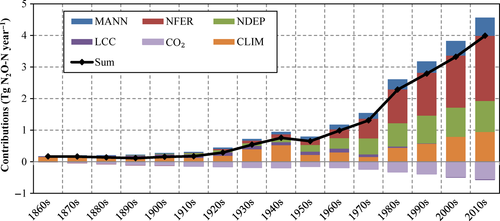
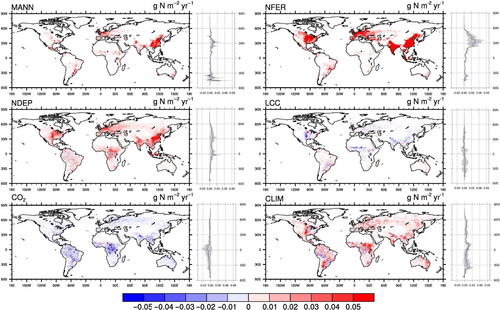
The effect of climate (CLIM) was found to stimulate soil N2O emissions by an estimated 0.9 ± 0.3 Tg N2O-N/year during 2007–2016, ranging between 0.6 Tg N2O-N/year (LPX-Bern) and 1.2 Tg N2O-N/year (LPJ-GUESS; Supporting Information Figure S6). The regression of the CLIM effect on soil N2O emissions simulated by each NMIP model against global average temperature (Supporting Information Figure S7) indicated the strong linear correlation with a transient temperature sensitivity of global soil N2O emissions by 0.6 ± 0.2 Tg N2O-N/year per unit warming (°C). This sensitivity is higher than that estimated by Zaehle (2013) (0.5 Tg N per year/°C), but lower than the estimate of Xu-Ri et al. (2012) (1 Tg N per year/°C). Rising CO2 concentration reduced global soil N2O emissions with its effect increasing through time. In the recent decade, the CO2 effect reduced global soil N2O emissions by 0.6 ± 0.6 Tg N2O-N/year, equivalent to 10% of the N2O emissions in preindustrial level. The linear regression of CO2 concentration against soil N2O emissions (Supporting Information Figure S7) indicated that the transient sensitivity of global soil N2O emissions to rising CO2 concentration was −4.6 Gg N2O-N per year/ppm. The negative CO2 effect is likely caused by the increased vegetation N use efficiency and higher N uptake from soils. LPJ-GUESS simulated the strongest CO2 reduction effect on global soil N2O emissions (−1.8 Tg N2O-N/year in the recent decade). ORCHIDEE-CNP is the only model simulating a small positive CO2 effect (0.1 Tg N2O-N/year in the recent decade) likely due to the simulated CO2 effect on soil moisture and substrate availability. LCC had minor impacts on soil N2O emissions when manure and mineral fertilizer use were not used. Model ensemble results showed that LCC effects on emissions were close to neutral (−0.0 ± 0.5 Tg N2O-N/year in the recent decade), indicating that LCC can either increase or decrease soil N2O emissions over different regions. Model results of LCC effect diverged, ranging between −0.9 Tg N2O-N/year (LPJ-GUESS) and 0.4 Tg N2O-N/year (ORCHIDEE). Four models (LPX-Bern, ORCHIDEE, DLEM, and ORCHIDEE-CNP) simulated positive effect, two models (OCN and LPJ-GUESS) simulated negative effect, and one model (VISIT) simulated a nearly neutral effect.
Significant changes were found in the driving factors between the preindustrial period and the contemporary period over all of the 18 regions (Supporting Information Table S4). The top five regions for increases in N addition (NDEP + MANN + NDEP) were CHN (47 Tg N/year), SAS (26.6 Tg N/year), EU (18.4 Tg N/year), USA (16.3 Tg N/year), and SEAS (11.9 Tg N/year). The contributions of driving factors to changes in soil N2O emissions varied across regions (Figure 8). Spatially, in the recent decade, MANN effects were stronger in East CHN and EU. NFER had the strongest effects in stimulating soil N2O emissions between 20°N and 50°N, particularly in East US, EU, SAS, East CHN, and SEAS. The impacts of NDEP, CO2, and CLIM were more uniformly distributed across the global land area, although NDEP impacts were stronger in EAST US, EU, SAS, East CHN, and SEAS. Rising CO2 concentration reduced soil N2O emissions over most of the global land areas, with stronger impacts in the tropics.
At the regional level, NFER was the key factor in enhancing soil N2O emissions over seven regions, namely, USA, EU, MIDE, CHN, KAJ, SAS, and SEAS (Figure 9). For each of the seven regions, NFER effect contributed at least 40% of the increased soil N2O emissions. Particularly, the contributions of NFER reached up to 63% in CHN and 74% in SAS. In contrast, CLIM was the dominant factor affecting soil N2O emissions in ten regions with less intensive human management activities, including CAN, CAM, NSA, BRA, SSA, NAF, EQAF, SAF, RUS, and OCE (Figure 9).
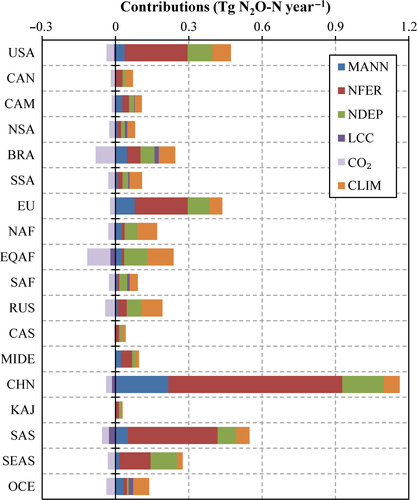
4 DISCUSSION
4.1 Preindustrial soil N2O emissions
Preindustrial N2O emissions were recently estimated from ice core and marine N2O measurements (Battaglia & Joos, 2018). The preindustrial atmospheric lifetime of N2O (Prather et al., 2015) in combination with the ice core N2O concentration measurements (Macfarling Meure et al., 2006) yields a net global preindustrial N2O source to the atmosphere of 10.5 ± 1.0 Tg N2O-N/year. Marine N2O emissions were constrained in a Bayesian model framework by water column and surface water N2O measurements and preindustrial emission was estimated to be between 3.1 and 6.1 Tg-N/year. This implies by difference with the total source a preindustrial soil N2O source of about 5.9 (4.1–7.7) Tg N2ON/year (Battaglia & Joos, 2018). This value is consistence with our multi-model estimate of 6.3 ± 1.1 Tg N2O-N/year in the preindustrial era. Our average preindustrial soil N2O emissions from other ecosystems were estimated to be 6.0 Tg N2O-N/year, which is 0.3 Tg N2O-N/year higher than the estimate of Xu et al. (2017), but 0.7 Tg N2O-N/year lower than the estimate of Bouwman et al. (1993). Direct N2O emissions from global cropland soil in this study (0.3 Tg N2O-N/year) is consistent with the EF-based estimate of 0.3 Tg N2O-N/year by Syakila & Kroeze (2011).
The simulated soil N2O emissions showed significant spatial variations across global land areas. In this study, soil N2O emission density (N2O emission per land area) was higher in the tropics, especially in the Congo and Amazon rainforests (Figure 2a). The lowland tropical ecosystems have higher biological N fixation (BNF) rate (Hedin, Brookshire, Menge, & Barron, 2009; Vitousek, Menge, Reed, & Cleveland, 2013), are often phosphorus-limited relative to N (Reich & Oleksyn, 2004; Vitousek, 1984), and are associated with optimum temperatures and soil moistures for microbial decomposition organic matter and produce soil N2O (Butterbach-Bahl et al., 2013). According to Bouwman et al. (1993) and Xu et al. (2017), the tropics accounted for more than half of the global soil N2O emissions, which is consistent with the result in this study. Smaller soil N2O emission density was found in the boreal areas (Figure 2a), which is mainly caused by the fact that boreal and temperate ecosystems are more limited by N availability and the cold weather suppressed microbial activities (Alexander & Billington, 1986).
4.2 Contemporary soil N2O emissions
The NMIP model ensemble mean indicates that global N2O emissions from natural soils were 6.5 ± 1.2 Tg N2O-N/year during 1981–2016, which is consistent with rates reported by the IPCC AR5 (6.6 [3.3–9.0] Tg N2O-N/year; Ciais et al., 2014). Saikawa et al. (2014) estimated N2O emissions from natural soils during 1995–2008 by using a top-down inversion approach, and reported that the average emissions were 7.1 Tg N2O-N/year (lowest value: 4.7 ± 0.65 Tg N2O-N/year in 1995; highest value: 8.4 ± 0.47 Tg N2O-N/year in 2001). NMIP models estimated comparable natural soil N2O emissions of 6.6 Tg N2O-N/year in the same 14-year period.
For soil N2O emissions in cropland, significant divergences emerge between previous estimates and this study. Global agricultural N2O emission in the contemporary period was reported as 4.1 (1.7–4.8) Tg N2O-N/year in the IPCC AR5 (Ciais et al., 2014), including both direct soil N2O emissions and N2O emissions from animal production. In this study, we only included direct soil N2O emissions, which was 3.3 ± 1.2 Tg N2O-N/year in the recent decade. By using IPCC 2006 EF, Del Grosso, Wirth, Ogle, and Parton (2008) estimated N2O from direct soil emissions of 3.8 Tg N2O-N/year in 2000 with emissions from livestock excreta included, which was 46% higher than our result in 2000 (2.6 Tg N2O-N/year). Syakila and Kroeze (2011) estimated the direct cropland N2O emissions in 2006 as 2.2 Tg N2O-N/year, which was 24% lower than our result in 2006 (2.9 Tg N2O-N/year). FAOSTAT provided long-term estimates of N2O emission from different sectors in agriculture based on the IPCC Tier1 guideline (FAOSTAT, 2016). Combining emissions from synthetic N fertilizer and manure application, crop residues and cultivated organic soils, FAOSTAT reported the 10-year average cropland soil N2O emissions to be 1.9 Tg N2O-N/year during 2007–2016. Our estimate (3.3 Tg N2O-N/year) is 74% larger than FAOSTAT estimate in the same period. EDGAR (Janssens-Maenhout et al., 2017) provided global N2O emissions during 1970–2012 with the global direct cropland soil emissions of 1.3 Tg N2O-N/year in the 1980s, 1.5 Tg N2O-N/year in the 1990s, and 1.7 Tg N2O-N/year in the 2000s. Our estimates in these three decades (2.2 in the 1980s, 2.5 in the 1990s, and 2.8 Tg N2O-N/year in the 2000s) are higher than EDGAR estimates. The differences highlight the large uncertainties in the previously estimated N2O emissions and the possible caveats of the NMIP models.
4.3 Soil N2O emissions in response to natural and anthropogenic factors
At the global scale, the EF for direct N2O emissions caused by fertilizer use has been established at ~1% but is considered highly uncertain (Bouwman et al., 2002; De Klein et al., 2006; Gerber et al., 2016; Shcherbak et al., 2014; Smith, Mosier, Crutzen, & Winiwarter, 2012). Davidson (2009) derived, from global top-down estimates, an emission factor of 2.5%, which, however, covers both direct and indirect emissions. According to the results of this study, the ratio of NFER effect (2.0 ± 0.8 Tg N2O-N/year) to global total mineral N fertilizer use (113 Tg N2O-N/year) was 1.8 ± 0.7% in the recent decade. The model-derived N2O emissions in this study consider NFER direct effect as well as the legacy effect resulting from historical soil N accumulation that was not accounted by IPCC. For natural ecosystems, Liu and Greaver (2009) conducted a meta-data analysis by collecting field observations and found that N enrichment significantly enhanced soil N2O emissions. NMIP models simulated considerable effects of N addition on soil N2O emissions, which was consistent with Liu and Greaver (2009). However, the simulated soil N2O emissions in response to N addition (fertilizer and manure N applications, and N deposition) show large divergence among the participated NMIP models (Supporting Information Figure S6). These divergences are primarily caused by the differences in model representation of N processes and parameterization schemes among models (Tian et al., 2018).
Regarding the CLIM effect, experiment-based studies illustrated that warming generally enhanced soil N2O emissions (Smith, 1997) and the denitrifying bacteria community may adapt to higher temperature (Pärn et al., 2018), which is in line with the results simulated by the NMIP models. The positive feedbacks between soil N2O emissions and climate warming should be seriously taken into consideration when designing national climate change policies. Variations in precipitation affect microbial processes and soil N dynamics and the corresponding soil N2O effluxes (Austin, 2011; Dijkstra, Augustine, Brewer, & Fischer, 2012). The soil drying and wetting cycles caused by rainfall can trigger a considerable N2O emission pulse (Barton et al., 2008; Davidson et al., 1993; Van Haren et al., 2005). It is important to better simulate soil N2O emissions associated with the precipitation regimes of extreme dry and wet events. In addition, the freeze-thaw induced N2O emissions have recently been reported to make up 17%–28% of global agriculture N2O emissions (Wagner-Riddle et al., 2017), which need to be considered in future model development.
For CO2 effect, previous studies based on model simulations (Kanter, Zhang, Mauzerall, Malyshev, & Shevliakova, 2016; Xu et al., 2012; Xu-Ri et al., 2012) reported that the rising CO2 concentration suppressed soil N2O emissions from land ecosystems through stimulating vegetation N uptake and possibly N use efficiency and reducing soil inorganic N concentration. However, observation-based results diverged among ecosystem types. For example, Phillips, Whalen, and Schlesinger (2001) reported a reduced N2O emissions during growing season at forest site while Moser et al. (2018) and Regan et al. (2011) suggested that atmospheric CO2 enrichment stimulated soil N2O emissions in grasslands by increasing soil moisture content, and enhancing root biomass and soil biological activity. CO2 effect on N2O emissions could depend on the availability of soil mineral N for plant uptake (Kanter et al., 2016), and then diverges among ecosystems with varied N limitation strength (Xu et al., 2012). However, the magnitude of CO2 effect on N2O emissions is still poorly understood at the global level. Of the seven NMIP models, ORCHIDEE-CNP was the only one model that simulated a positive CO2 effect, consistent with the meta-analysis of Van Groenigen, Osenberg, and Hungate (2011).
Without the effects of fertilizers and manure added to agricultural lands converted from natural lands, the vegetation types prior to and after land conversion determined LCC effect on soil N2O emissions. Humid forests usually have a higher N2O emission density, while grassland and shrub have lower N2O emission density (Potter et al., 1996). In South and Central America, soil N2O emissions increased following deforestation but then declined with cropland age, resulting in lower N2O emissions from secondary forests and cropland compared to the mature forests that they replaced (Keller & Reiners, 1994; Melillo et al., 2001; Verchot et al., 1999). In the past several decades, large areas of tropical and temperate forests had been converted to cropland. If cropland management practices were not included, cropland soils would emit less N2O than mature forests. NMIP simulations show large divergence in LCC effects on soil N2O emissions among the seven models.
4.4 Uncertainties associated with model structure, parameters, and drivers
Although all the models used consistent input data, model structure and parameterizations diverged considerably, leading to the different spatial and temporal patterns of the simulated N2O emissions by models (Supporting Information Figure S2–S6). In the preindustrial period, larger standard deviation of the simulated soil N2O emissions occurred in the tropical areas (Supporting Information Figure S2). This is mainly caused by the large N fluxes in tropical ecosystems and the divergences in model representations of these processes. For example, LPJ-GUESS parameterizes BNF based on evapotranspiration (ET) rate, while ORCHIDEE-CNP estimates BNF based on ecosystem Net Primary Productivity (NPP) (Cleveland et al., 1999). This difference could lead to large divergences in the simulated BNF (Meyerholt, Zaehle, & Smith, 2016), and the NPP-based algorithm tends to estimate higher BNF in the tropics than ET-based algorithm (Wieder, Cleveland, Lawrence, & Bonan, 2015). In addition, N losses (e.g., N denitrification, NH3 volatilization, and N leaching) have also been parameterized differently in NMIP models (Tian et al., 2018), which could result in large uncertainties in the simulated organic N storage and mineral N availability in the tropical region (Meyerholt & Zaehle, 2018).
Over the recent decades, regions with large standard deviation of the simulated soil N2O emissions shifted to East CHN, US Midwest, and India (Supporting Information Figure S3), where cropland is extensively distributed. This is likely caused by model uncertainties in representing crop cultivation and management, such as manure use, mineral fertilizer application, and crop type. For example, DLEM (Zhang, Tian, Yang, & Pan, 2018) and LPJ-GUESS (Lindeskog et al., 2013) parameterize cropland processes based on crop species (e.g., wheat, corn, rice, soybean, and cotton) while crops in VISIT are grouped into paddy, generic C3 crop (e.g., wheat), and warm C4 crop (e.g., maize). Manure use in cropland is another important uncertainty source. For example, ORCHIDEE simply assumes that all manure N applied to cropland is mineralized and added into the soil mineral N pool while ORCHIDEE-CNP considers organic manure N addition in urine and feces forms and adds manure into litter and soil organic pools. Manure N, unlike fertilizer N, is obtained from the terrestrial processes, and thus, without removing this N from other places in the terrestrial biosphere, applying the N manure fertilizer could create a nonexisting source of N in these models, which could cause more soil N2O emissions than actually implied.
It should be noted that some factors influencing soil N2O emissions were not represented by the participating models. In pasture and rangeland, a large amount of N2O is emitted from livestock excreta deposition, manure, and mineral fertilizer application (Davidson, 2009; Steinfeld et al., 2006). However, this study did not consider the impacts of pasture management practices and livestock excreta deposition, which could result in underestimated soil N2O emissions in managed grasslands. According to Oenema, Velthof, Yamulki, and Jarvis (1997), the contribution of grazing animals was about 1.6 Tg N2O-N/year in the 1990s. Except for fertilization and manure use, other cropland management practices (such as irrigation, tillage, legumes, and straw management) were not included in the current NMIP. Previous studies found that cropland management practices could change soil physical conditions, microbial activities, and then soil N2O emissions (Bouwman et al., 2002; Liu et al., 2011; Smith & Conen, 2004). The missing cropland management in models could lead to larger model uncertainty range. In addition, the impacts of ecosystem disturbances (such as wildfires, hurricane, and logging) were not well parameterized in the NMIP models, largely due to our current knowledge gap regarding the impacts of land disturbances on soil N2O emissions. Observational results in previous studies diverged: Some studies reported increased N2O emissions after burning (Ishizuka, Tsuruta, & Murdiyarso, 2002; Karhu et al., 2015; Levineet al., 1990, 1988), while other studies found no significant differences in N2O emissions between burned site and unburned site (Hao, Scharffe, Crutzen, & Sanhueza, 1988; Takakai et al., 2006). Additionally, the effect of freeze-thaw on N2O emissions has not been fully represented by NMIP models, although some models simulating the freeze-thaw cycle could presumably represent the trapped N2O under the frozen soil layer.
5 RECOMMENDATION AND OUTLOOK
This study provided a processed-based modeling assessment of global and regional soil N2O emissions during 1861–2016 and disentangled the underlying mechanisms of the changed patterns by factorial analysis. However, large uncertainties existed not only in the emission magnitude, spatial pattern, temporal trend, but also in the contributions of natural and anthropogenic factors. According to the discussions on model uncertainties and the contributing factors, here, we offer the following recommendations for model improvement and future research needs.
5.1 Improving model representation of key processes responsible for N2O fluxes
Soil N2O formation takes place as a result of nitrification and denitrification processes. Responses of nitrification and denitrification processes to soil conditions and substrate availability are particularly important to accurately simulate soil N2O emissions. N2O emissions in these processes need to be validated against observations at different water-filled pore space levels (Bateman & Baggs, 2005; Bollmann & Conrad, 1998; Diem et al., 2017), soil and vegetation types (Ambus, 1998; Maag & Vinther, 1996), temperature (Maag & Vinther, 1996), and substrate levels (Weier, Doran, Power, & Walters, 1993). In addition, other N-related fluxes and processes such as BNF, N leaching, and ammonia (NH3) volatilization also introduced large uncertainties in the simulated soil N concentration (Meyerholt & Zaehle, 2018; Wieder et al., 2015). Explicit representation of these processes is in a critical need for enhancing model simulation accuracy. Cropland manure application accounted for ~15% of the increased global soil N2O emissions. The transformation of manure organic N to inorganic N could alter soil NH4+ and NO3− concentrations. The decomposition of manure organic components and N mineralization are in need to be better parameterized by models. It is also necessary to ensure mass conservation for manure addition in cropland by removing C and N from other ecosystems. Field-based studies found that tillage, irrigation, legumes cultivation could alter soil physical and chemical characteristics and N concentration (Jangid et al., 2008; Smith & Conen, 2004) and should be parameterized to reduce uncertainty in cropland emissions. N addition in pasture and rangeland (such as livestock excreta deposition, manure, and mineral fertilizer application) is an important source of global soil N2O emissions (Davidson, 2009; De Klein & Eckard, 2008), accounting for more than half of the global agriculture N2O emissions (Dangal et al., In revision). However, these processes were not included in the current NMIP simulation protocol. The consideration of N addition in managed grasslands is an essential task for NMIP to estimate grassland soil N2O emissions accurately. Other processes, such as peatland drainage (Inubushi, Furukawa, Hadi, Purnomo, & Tsuruta, 2003), wildfires occurrence (Levine et al., 1990), and freeze-thaw cycle (De Bruijn, Butterbach-Bahl, Blagodatsky, & Grote, 2009; Mørkved, Dörsch, Henriksen, & Bakken, 2006; Wagner-Riddle et al., 2017; Wolf et al., 2010) have also been found to influence soil N2O emissions, and need to be considered by future model development. The indirect N2O emissions from soils could be estimated according to the model-simulated N leaching and volatilization in combination with the IPCC Tier 1 emission factors (De Klein et al., 2006). In addition, terrestrial models could be linked with hydrological models to simulate lateral N2O emission from the land–aquatic continuum (Klatt et al., 2017).
5.2 Improving simulations of soil N2O response to individual and combined factors
Large divergence among models existed in attributing soil N2O emissions to different driving factors (Supporting Information Figure S6). As these driving factors would change dramatically in the future, it is impossible to correctly project future soil N2O emissions if the contributions of these factors were not well understood. Field observations of single factor effect are important for validating model responses. For example, N addition experiments have been widely conducted in natural ecosystems, pasture, and croplands (Bouwman et al., 2002; Liu & Greaver, 2009; Meng, Ding, & Cai, 2005; Shcherbak et al., 2014; Zou, Huang, Jiang, Zheng, & Sass, 2005). These datasets are valuable for understanding the impacts of fertilizer use and N deposition, and validating model-simulated magnitude of soil N2O emissions due to N enrichment. In addition, the measurements of N2O emissions in FACE experiments (Ineson, Coward, & Hartwig, 1998; Regan et al., 2011; Reich et al., 2006) can be used to explain the effects of rising CO2 concentration and climate warming on soil N2O emissions. Precipitation manipulation experiment (Beier et al., 2012) may provide an opportunity to better parameterize models for the effect of soil drying and wetting cycles caused by changed precipitation regimes. Better representation of the multifactor effects represents a critical challenge for reducing model uncertainties in projecting future soil N2O emissions.
5.3 Improving the quality of input data sets
Input datasets of land management practices are large sources of uncertainties in the N2O emissions reported here. For NMIP at the current stage, fertilizer data provided the total amount of inorganic N, rather than the amount of N in different forms (i.e., NH4+ and NO3−). Nishina, Ito, Hanasaki, and Hayashi (2017) reported that although global N fertilizer amount increased continuously between 1961 and 2010, the fraction of NO3− in N fertilizer reduced from 35% to 13%. Fertilizer form could affect soil NH4+ and NO3- concentrations, and then nitrification and denitrification processes (Hénault, Devis, Lucas, & Germon, 1998). The frequency and timing of fertilizer application could affect the daily and monthly variations of soil N2O emissions (Smith & Dobbie, 2001). Fertilizer use rate varied considerably among crop types, which contributed to the large uncertainties in estimating cropland N2O emissions (Ruser, Flessa, Schilling, Beese, & Munch, 2001). Thus, detailed information of fertilizer application (such as fertilizer form, frequency, timing, and crop-specific application rate) is necessary to be included in the development of fertilizer datasets. In addition, time series of cropland management practices, including legume cultivation, tillage, and irrigation, should be developed to drive NMIP models. For cropland area, NMIP used HYDE 3.2 dataset, the quality of which was questionable in some regions, such as continental US (Yu & Lu, 2018) and Asia (Calle et al., 2016; Tian, Banger, Bo, & Dadhwal, 2014). To better represent cropland area, regional long-term cropland area datasets with higher accuracy (Liu & Tian, 2010; Tian et al., 2014; Yu & Lu, 2018) need to be incorporated into HYDE dataset to drive models.
5.4 Enhancing data-model integration for improving model performance at multiple scales
Soil N2O emissions have been measured across various land ecosystem types and regions by using multiple measurement approaches, including chamber measurements (Smith & Dobbie, 2001), eddy covariance (Jones et al., 2011), and laboratory incubation (Miller et al., 2008). To understand soil N2O emissions at a large scale, national and global N2O flux measurement networks were established such as the Long-Term Agroecosystem Research Network (LTAR) (Walbridge & Shafer, 2011), International Long-Term Ecological Research Network (ILTER) (Vanderbilt & Gaiser, 2017), Greenhouse Gas Reduction through Agriculture Carbon Enhancement Network (GRACEnet; Jawson, Shafer, Franzluebbers, Parkin, & Follett, 2005), and the National Agricultural Nitrous Oxide Research Program (NANORP; Dalal, Wang, Robertson, & Parton, 2003). A recent study of data-model comparison and benchmarking effort has been conducted to estimate site-level N2O emissions in cropland and grassland (Ehrhardt et al., 2018). Global terrestrial N2O emissions have also been reconstructed from ice core isotope data over periods of past abrupt climate change allowing for N2O model evaluation on the century time scale (Schilt et al., 2014). These observational data could be used to validate model performance and constrain large-scale model simulations. More effect in data assimilation and data-model integration at multiple spatial and temporal scales is clearly needed for improving model accuracy in estimating global and regional N2O fluxes.
ACKNOWLEDGEMENTS
This study has been supported partially by National Key R & D Program of China, Grant/Award Number: 2017YFA0604702, 2018YFA0606001; US National Science Foundation (1210360, 1243232), CAS Grants (KFJ-STS-ZDTP-0; SKLURE2017-1-6), AU-OUC Joint Center Program and Auburn University IGP Program. A. Arneth acknowledges support from the Helmholtz Association (Impulse and Networking fund, and ATMO programme) and EU FP grant LUC4C (603542). S. Olin acknowledges support from the strong research areas BECC and MERGE together with support from LUCCI (Lund University Centre for studies of Carbon Cycle and Climate Interactions). F. Joos and S. Lienert acknowledge support by the Swiss National Science Foundation (#200020_172476). C. Peng acknowledges the support from the Natural Sciences and Engineering Research Council of Canada (NSERC) Discovery Grant. W. Winiwarter acknowledges the support by the Austrian Science Fund (FWF, project number P29130-G27). A. Ito acknowledges support from grant-in-aid by the Japan Society for Promotion of Science (17H01867).
CONFLICT OF INTEREST
The authors declare no conflict of interest.



